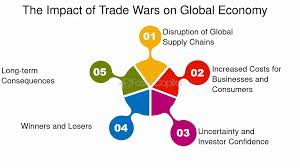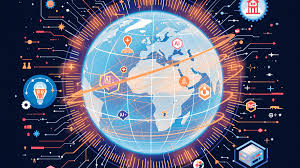Why the IMF Boss Is Right: 'Buckle Up' for the Global Economy's Multiple Menaces
Key Takeaways
- The global economy is holding up better than expected, but big risks like trade tariffs and an AI bubble could cause trouble soon.
- IMF boss Kristalina Georgieva says uncertainty is the new normal, with growth stuck around 3% – we need better policies to boost it.
- Companies like John Deere are feeling the pain from tariffs and weak demand, showing how these menaces hit real businesses.
- Governments must fix debts, cut red tape, and promote fair trade to create more jobs and opportunities.
- Stay informed and prepare: the world economy could face sharp corrections if things go wrong.
Introduction
Imagine you're on a rollercoaster. It starts slow, but then twists and turns come fast. That's how the global economy feels right now. The boss of the International Monetary Fund (IMF), Kristalina Georgieva, recently told the world to "buckle up." She leads a major organization that advises countries on financial and economic issues. In a speech just days ago, she said uncertainty is the new normal. Why? Because the world is changing fast, and not always in good ways.
Kristalina Georgieva, Managing Director of the IMF
Let's think about what this means. The global economy is like a huge web connecting countries, businesses, and people. When one part shakes, others feel it. Georgieva spoke at a special event before the IMF's big yearly meeting. She pointed out that things aren't as bad as some feared earlier this year. No big recession in the US, and many places are still growing. But it's not great either. Growth is slow, around 3% for the next few years. That's less than before the pandemic, when it was about 3.7%.
Why is the economy holding up? Georgieva gave four reasons. First, better rules and plans from governments. Countries have improved how they handle money, like controlling inflation and building stronger banks. Second, businesses are quick to adapt. They've stocked up on goods before prices rise and changed where they buy things from. Third, tariffs – those extra taxes on imports – haven't been as harsh as thought. In the US, they've gone down a bit recently. Fourth, money is easy to borrow right now, thanks to excited stock markets, especially around AI.
But here's the hook: this strength might not last. Georgieva warns that tests are coming. Think about trade wars. US President Donald Trump has slapped high tariffs on China over things like rare earth minerals. Markets dropped when he threatened 100% extra taxes. This could make things cost more for everyone. Then there's AI. It's booming, but valuations are sky-high, like the dotcom bubble 25 years ago. If it bursts, stock markets could crash, hurting jobs and savings worldwide. People are worried. Young folks in many countries are protesting for better chances. In places like Lima or Nairobi, they want jobs and fair pay. Even in the US, kids are less likely to earn more than their parents. This discontent leads to big policy changes, like tougher rules on trade and immigration. The global economy has grown a lot over the decades. People live better now. But gaps are wide. Some get rich, others struggle. Transformations are happening: wars between countries, new tech like AI, populations growing or shrinking, and climate change harming the planet. All this makes uncertainty climb high. Trade is a bright spot so far. The UN says global trade grew by over $500 billion in the first half of 2025. That's despite tensions. Developing countries are leading, with more trade between them. But prices are starting to rise, and imbalances could cause problems. Debt is another menace. Governments owe a lot – over 100% of what the world makes by 2029. This means less money for schools or health. Rich countries give less aid to poor ones. Everyone needs to fix their finances.Georgieva calls for action. Lift growth by cutting red tape, so businesses can start easily. In Asia, more trade inside the region could add 1.8% to GDP. Africa could gain 10% per person with reforms. Europe needs to finish its single market.
In this intro, I want to set the scene. The IMF boss isn't scaring us for fun. She's pointing to real menaces so we can prepare. As we dive deeper, we'll look at each threat, with examples like how tariffs hit John Deere's stock. By the end, you'll know what to watch and maybe how to protect yourself. Let's explore why buckling up is smart for the global economy.
Understanding the IMF Boss's Warning
The IMF is like a global watchdog for money. Kristalina Georgieva, its boss, gave a speech called "Opportunity in a Time of Change." She remarked that the world is constantly changing and that uncertainty is now a permanent feature. This isn't just talk – it's based on data from experts.
What Does 'Buckle Up' Mean for the Global Economy?
'Buckle up' means get ready for bumps. The global economy has been resilient, meaning it bounces back from problems. But tests are coming. For example, gold demand is surging because people see it as safe when things are shaky. Holdings are over 20% of the world's reserves.
Growth is okay, but slow. The IMF sees 3.0% in 2025 and 3.1% in 2026. That's better than feared, but we need more to create jobs. China is slowing, India is rising.Practical tip: If you're investing, watch for signs of slowdown. Diversify your savings to include safe assets like bonds.
Key Menaces Facing the Global Economy
The IMF boss lists multiple menaces. Let's break them down.
Trade Wars and Tariffs: A Growing Threat
Trade wars are when countries put taxes on each other's goods. Trump has raised tariffs on China to 100% on minerals. This made markets fall. The US average tariff is 17.5%, higher than before.
But trade grew $500 billion in early 2025. Developing countries lead, with South-South trade up. Still, if tariffs spread, prices rise for consumers. Example: Companies front-load buys to avoid hikes. But this can't last. UNCTAD says growth continues, but prices are up in Q3.Tips:
- Businesses: Look for new suppliers in friendly countries – that's 'friendshoring.'
- Individuals: Budget for higher costs on imported goods like electronics.
Geopolitical tensions add risk. Conflicts disrupt shipping and energy.
The AI Bubble: Boom or Bust?
AI is exciting, but risky. Valuations are like the 2000 dotcom era. 20% of trade growth is in AI goods like chips. It's masking weak spots in the US economy.
The Bank of England warns of a sudden drop if AI hype fades. This could tighten money, hurt growth, especially in poor countries. Example: Tech stocks are high, but cross-ownership raises flags.Tips:
- Investors: Don't put all eggs in the AI basket. Balance with other sectors.
- Workers: Learn AI skills, but prepare for job changes.
Other menaces: High debt, imbalances in trade surpluses/deficits. The US deficit is big, and China's surplus is steady.
Case Study: The Deere Stock Example – How Menaces Hit Real Businesses
Let's look at John Deere, a big farm machine maker. Their stock shows how global menaces affect companies.
Deere's stock fell 8% after a recent earnings report. Why? Tariffs cost them $600 million this year. Farmers struggle with low crop prices and high costs, so they buy less.
Sales for big machines could drop 15-20% in 2025. Earnings fell from $34.63 in 2023 to about $18.55 now. Layoffs happened as demand slowed.This links to the global economy. Trade wars raise import costs for parts. Weak world demand hits farmers' exports. AI in farming helps, but not enough yet.
Deere is undervalued by 43.8%, some say. But risks remain. Analysts are cautious.
This example shows: Menaces like tariffs hurt supply chains. Businesses adapt, but consumers pay more. For Deere, it's a cycle – a bad economy means fewer sales, and stock drops.
Tips for similar firms:
- Diversify markets: Sell more in growing areas like India.
- Innovate: Use AI for smarter machines.
- Lobby for fair trade.
Deere's story is a warning. If global menaces worsen, more companies could suffer.
How Governments Can Fight Back
Georgieva says fix three things: Boost growth, repair finances, fix imbalances.
Boosting Growth and Cutting Red Tape
Cut rules that slow businesses. Strong laws protect property and encourage competition.
In Europe, finish the single market. US mega-firms show private power.Tips:
- Start-ups: Use online tools for easy setup.
- Governments: Appoint leaders to drive changes.
Fixing Debts and Imbalances
Debt is rising. Cut spending wisely. US: Save more, cut deficit. China: Spend on safety nets, less on industry.
For more on tariffs, check our post: How Tariffs Shape Business Strategies. Or Understanding AI in the Economy.
External: IMF's site and UNCTAD reports.
Conclusion
The IMF boss is spot on – buckle up for the global economy's menaces like trade wars, AI risks, and debts. We've seen resilience, but tests loom. From Georgieva's speech to Deere's struggles, it's clear that action is needed.
Summary: Growth slowed at 3%, trade up but risky, businesses hurt by tariffs. Governments must reform for better opportunities.
Call to action: Subscribe to our blog for updates on the global economy. Share your thoughts below – how are these menaces affecting you?




No comments:
Post a Comment